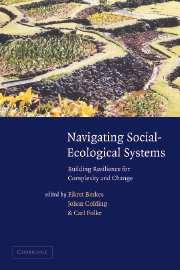Book contents
- Frontmatter
- Contents
- List of contributors
- Preface
- Acknowledgements
- Foreword: The backloop to sustainability
- 1 Introduction
- Part I Perspectives on resilience
- Part II Building resilience in local management systems
- Part III Social-ecological learning and adaptation
- Part IV Cross-scale institutional response to change
- 11 Dynamics of social–ecological changes in a lagoon fishery in southern Brazil
- 12 Keeping ecological resilience afloat in cross-scale turbulence: an indigenous social movement navigates change in Indonesia
- 13 Policy transformations in the US forest sector, 1970–2000: implications for sustainable use and resilience
- 14 Synthesis: building resilience and adaptive capacity in social–ecological systems
- Index
- References
13 - Policy transformations in the US forest sector, 1970–2000: implications for sustainable use and resilience
Published online by Cambridge University Press: 13 August 2009
- Frontmatter
- Contents
- List of contributors
- Preface
- Acknowledgements
- Foreword: The backloop to sustainability
- 1 Introduction
- Part I Perspectives on resilience
- Part II Building resilience in local management systems
- Part III Social-ecological learning and adaptation
- Part IV Cross-scale institutional response to change
- 11 Dynamics of social–ecological changes in a lagoon fishery in southern Brazil
- 12 Keeping ecological resilience afloat in cross-scale turbulence: an indigenous social movement navigates change in Indonesia
- 13 Policy transformations in the US forest sector, 1970–2000: implications for sustainable use and resilience
- 14 Synthesis: building resilience and adaptive capacity in social–ecological systems
- Index
- References
Summary
Introduction
State bureaucracies managing forests are known to develop problems because of command-and-control mentalities and political links to legislatures and industry (Baskerville, 1995; Holling and Meffe, 1996). Command-and-control thinking leads to simple models of ecosystem behavior, such as the sustained yield of a single ecosystem product like wood fiber. Such thinking, by suppressing complications, can lead to unpleasant surprises. Economic dependence on a short list of products, linked via politicians in powerful legislative positions who are supported by economic interests, can reinforce the thinking in a bureaucracy managing a natural resource. When the side-effects of the dominant approach create a crisis, either natural or political, will the crisis lead to changes in the social and political configurations that caused the problem? Gunderson, Holling, and Light (1995) emphasize the importance of crisis as a necessary condition for change. A crisis is not sufficient, however. This chapter explores conditions preventing and allowing change by examining the forest sector in the USA from 1970 to 2000.
Between 1970 and 2000, two similar scenarios occurred in the management of national forests in the USA. Each time, action began when a local problem of ecosystem imbalance induced litigation that led a court to stop Forest Service timber harvesting. After the first halt, Congress passed the National Forest Management Act, but the Forest Service continued high levels of wood fiber production. The impact of these cuts on an endangered species led to the second halt.
Information
- Type
- Chapter
- Information
- Navigating Social-Ecological SystemsBuilding Resilience for Complexity and Change, pp. 328 - 351Publisher: Cambridge University PressPrint publication year: 2002
References
Accessibility standard: Unknown
Why this information is here
This section outlines the accessibility features of this content - including support for screen readers, full keyboard navigation and high-contrast display options. This may not be relevant for you.Accessibility Information
- 2
- Cited by
